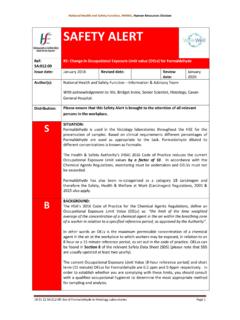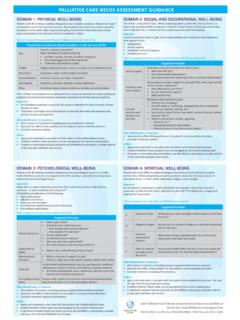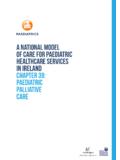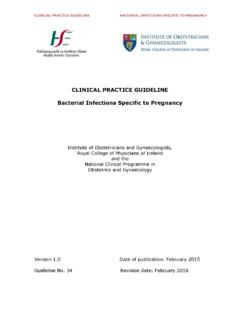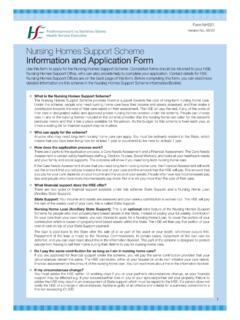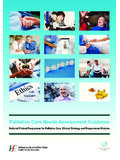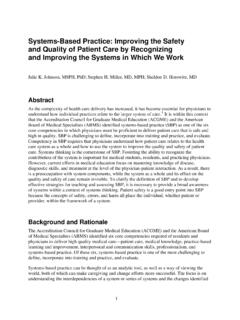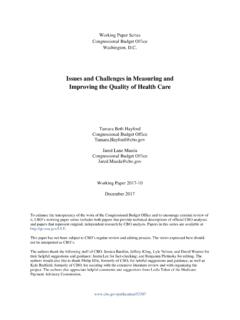Transcription of Framework for Improving Quality - Health Service Executive
1 Part 1: Introducing the FrameworkFramework for Improving Qualityin our Health ServiceFramework for Improving Qualityin our Health ServiceISBN: 978-1-78602-014-7-1- Framework for Improving Qualityin our Health Service1. Introduction 22. Defining Quality 33. Defining Quality Improvement 44. Purpose of Framework 5 5. Whole System Approach 66. Framework for Improving Quality 7 Leadership for Quality 8 Person and Family Engagement 10 Staff Engagement 12 Use of Improvement Methods 14 Measurement for Quality 16 Governance for Quality 187. Conclusion 208. Next Steps 21 References 22-2-Across the Irish healthcare system there is strong commitment to Improving the Quality of care1. This is evident from the various improvement initiatives being undertaken by frontline teams to larger developments and improvement programmes at group, organisation and system level.
2 Improving Quality is everybody s business and to achieve real and sustained improvements we must find new and better ways to achieve the outcomes that we want. The Health Service Executive (HSE) corporate plan is committed to Improving the Quality of care as set out in its vision: A healthier Ireland with a high Quality Health Service valued by all 2. International organisations provide insight into what can be achieved when Quality is placed at the core of all business. Intermountain Healthcare (Utah), Jonkoping County Council Healthcare system (Sweden) and Salford Royal Foundation Trust (UK) have steered their services to prioritise Quality above all else over the last number of decades and have achieved improved clinical outcomes, improved safety, reduced costs and reported improved patient experience 3,4,5. Our services are currently under considerable strain and the frontline environment is extremely busy and stretched.
3 It is exactly in this stressed environment where a focus on improvement is critical to orientate the planning and delivery of healthcare away from crisis management to proactive Service improvement. 1. InTROdUCTIOn -3- Quality of healthcare is defined in many ways by different healthcare systems. One of the most widely accepted definitions is that of the Institute of Medicine, USA where Quality is broken down into six domains: patient centred, safety, effectiveness, equity, timeliness and efficiency. In Ireland Quality is defined by the four Quality domains set out in the Safer Better Healthcare Standards6:1. Person centred - care that is respectful and responsive to individuals needs and values and partners with them in designing and delivering that care2. Effective - care that is delivered according to the best evidence as to what is clinically effective in Improving an individual s Health outcomes3.
4 Safe - care that avoids, prevents and minimises harm to patients and learns from when things go wrong4. Better Health and wellbeing - care that seeks to identify and take opportunities to support patients in Improving their own Health and wellbeing2. dEFInInG Quality Figure 1: definition of Quality within the Irish healthcare systemPeRSoN CeNtReDBetteR Health & WellBeINgSAFeeFFeCtIveQuAlIty oF CARe-4- Quality improvement (QI) is the combined and unceasing efforts of everyone - healthcare professionals, patients and their families, researchers, commissioners, providers and educators - to make the changes that will lead to better patient outcomes better experience of care continued development and supporting of staff in delivering Quality dEFInInG Quality IMPROvEMEnTFigure 2: defining Quality Improvement (adapted from Batalden, davidoff QualSafHealth Care 2007)BEttEr PatiEnt outcomEScontinuEd dEvEloPmEnt and SuPPortEd StaffBEttEr ExPEriEncE of carEQI-5-The Framework for Improving Quality is developed to influence and guide our thinking, planning and delivery of care in our services.
5 It is firmly orientated towards Quality , safety and to improve patient experience and outcomes. It provides a strategic approach to Improving Quality whether at the frontline, management, board or national level. The Framework is informed by international models and evidence 8,9,10 as well as local improvement experience and learning11,12. It has a clear aim to foster a culture of Quality that continuously seeks to provide safe, effective, person centred care across all services. Building such a culture is paramount to ensure long term progress to improve Quality of care. This document is the first part of the Framework for Improving Quality resource. It introduces the Framework and the drivers of Quality that make up the Framework . It is a high level Framework that will require testing at organisational level and with frontline wards, unit and teams.
6 This will provide the detail of how each of these drivers translates within these levels and settings. This information (Part 2 of the resource, being developed currently) will inform, support and guide organisations and teams in putting the Framework into action to foster a culture of Quality care that continuously seeks to improve. 4. PURPOSE OF Framework -6-This is a whole system Framework ; applicable across the different governance levels that currently exist. It provides a strategic approach to organise and plan to improve Quality driven services, at population, system and organisational level. The Framework can be used as a simple tool to aid system leaders, board members and senior managers in focusing efforts and resources towards the key areas for improvement encapsulated within the six drivers. It also supports greater coordination, alignment and focus for improvement work across services and helps to create the right conditions and environment for improvement.
7 For frontline teams and improvement initiatives the Framework acts as a reminder and sense check of the key areas that consistently require focus to ensure successful and sustainable improvements in the Quality of care even in the busiest environments. All work to improve the Quality of care through applying this Framework recognises the significant constraints which services continue to face. 5. wHOLE SySTEM APPROACHF igure 3: whole system approach Framework lEadErShiP tEam cEntral hSEPoPulationSfrontlinE tEamS and SErvicEScommunity hEalthcarE orgS hoSPital grouPSnaS-7-The Framework is comprised of 6 drivers for Improving Quality :1. leadership for Quality2. Person and Family engagement3. Staff engagement4. use of Improvement Methods5. Measurement for Quality6. governance for QualityFocusing on only one of the drivers within a Service will not give the desired effect for improvement.
8 It s the combined force of drivers working together that creates the environment and acceleration for improvement. A critical element in any movement to improve Quality is putting in place the supportive structures for Quality and funding leadership positions to drive improvement in organisations. 6. THE Framework FOR Improving QUALITyA culture of person centred Quality cAre thAt continuously improveslEadErShiP for QualityPErSon and family EngagEmEntStaffEngagEmEntuSE of imProvEmEnt mEthodSmEaSurEmEnt for QualitygovErnancE for QualityFigure 4: Framework for Improving Quality -8-LEAdERSHIP FOR QUALITyDriver 1-9-Leadership is the foundation stone within this Framework . Leadership supports and fosters a culture of continual learning and improvement: a culture that ensures patients are always at the centre of care planning and delivery and where staff are supported to deliver the care they aim to deliver - safe, effective and compassionate care13.
9 Leaders shape culture, create the conditions and model the behaviour necessary for Quality to flourish. Board members, senior leaders, managers and clinical leaders must seek out and obtain all opportunities to visibly demonstrate their commitment to building a culture of Quality ; actively demonstrating the values of the Service , regularly listening to patients and staff, seeking evidence of the Quality of our services. Leaders have the opportunity to be more than cheerleaders for Improving Quality of care; they can be active components:1. Prioritising a shared vision focused on Quality and constantly communicated to everyone2. Committing to building values, beliefs and norms that support Quality care3. Setting clear prioritised aims, objectives and expected outcomes for quality4. Building and supporting clinical leadership across the system5.
10 Effectively engaging with staff to enable them to improve their care and work environment6. Engaging with patients to ensure the Service is built around their ideas and priorities. 7. Committing resources to fund leadership positions for Quality improvement and supporting sustainable improvements in qualityLEAdERSHIP FOR QUALITyPERSOn And FAMILy EnGAGEMEnTDriver 2-10--11-Engaging and involving patients in the design, planning and delivery of all care demonstrates a commitment to person centred care. It ensures that care is appropriate to patients needs and is respectful of their preferences. Engagement builds a culture of listening to and learning from the care experiences of patients and their families. Focusing and delivering on the outcomes that matter to patients can only be achieved through meaningful engagement and partnership with patients, carers and their families14.
